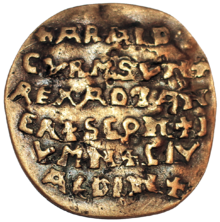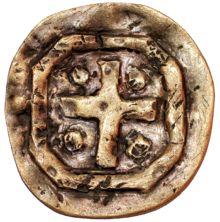Harald Blauzahn's gold disc
Harald Blauzahn's gold disc , also called Curmsun Disc after the Latinized form of Harald's last name Gormson , is a labeled gold disc on which the name of the Danish-Norwegian king Harald Blauzahn is mentioned in Latin . The disc, which became known to a wider public in 2014, is dated between 960 and 1125.
description
The concave disk has a diameter of 4.5 cm and a weight of 25.23 grams. Metallurgical investigations by the University of Lund in Sweden showed a gold content of between 83 and 92% and material impurities, as are known from golden artifacts of the early Middle Ages. The disc bears an inscription in Latin letters on the front: "+ ARALD CVRMSVN + REX AD TANER + SCON + JVMN + CIV ALDIN +". On the back there is an octagon that encloses a Latin cross. There are four points in the corners of the cross.
authenticity
The results of the material investigations speak in favor of production using medieval techniques. In contrast, the history of the find, the location and the context of the find are only passed down orally. According to this, the gold disc is said to have been discovered by chance as part of a Viking treasure in 1841 during renovation work in the medieval crypt of the church of Groß Weckow (today Wiejkówo ) a few kilometers east of Wollin in today's Poland. In fact, today's church in Groß Weckow was built in 1842 to replace a previous building that had burned down. The contemporary sources report nothing in this context about a treasure find. The context of the find is also not documented. It is said to have included four other artifacts, including a coin from Emperor Otto the Great . In the turmoil towards the end of the Second World War , the find is said to have come into private hands in 1945, before it first became known to a wider public in 2014. Because of the inscription, it caused considerable sensation in the tabloid press as well as in the professional world.
Interpretation and dating
Translated, the Latin inscription should read: "Harald Gormsøn King of the Danes, Scania, Jomsburg, City of Aldinburg." Harald is identified as Harald Blauzahn and Aldinburg as Oldenburg in Holstein . The Jomsburg is a legendary Viking castle, which is believed to be near where it was found. Scania refers to Skåne in today's Sweden . The dots in the corners of the cross could symbolize the four evangelists . The archaeologist Sven Rosborn suspects that the gold disc could have been made by Franconian monks in connection with Harald Blauzahn's funeral. According to a theory of the Danish archivist Steffen Harpsøe (published in the magazine Siden Saxo , published by Statens Arkiver ), the Curmsun Disc could have been made by the local clergy in the area around Wollin and Groß Weckow between 1050 and 1125 with the purpose of Harald to blue tooth canonize .
Remarks
- ^ The Curmsun Disc website - Metallurgical Analysis.
- ↑ zysk, Daniel Polish Press Agency , Science and Scholarship, 2014.
- ↑ Official Gazette of the Government in Stettin 1843 , p. 20.
- ↑ Rosborn, S. (2014) A unique object from Harald Bluetooth's time? Malmö: Pilemedia, pp. 4-5.
- ↑ Rosborn, S. (2014) A unique object from Harald Bluetooth's time? Malmö: Pilemedia, pp. 10-11.
- ↑ Harpsøe, S. (2015), Haraldsguldet - en mystisk guldskive fra fortiden , Siden Saxo No. 4 - 2015, Odense: Syddansk Universitetsforlag, ISSN 0109-6028 , pp. 25-27.


